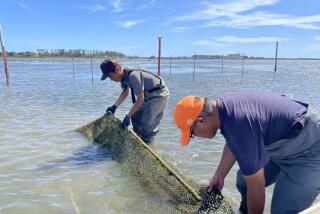Logging by Helium Balloons Gives Borneo Rain Forest an Ecological Lift : Environment: Aerial removal has been used in some timbering operations in the Western United States and Canada for more than two decades. Conservationists say method will help sustain and rejuvenate forests.
- Share via
Like a giant hand reaching down into a tropical rain forest on the island of Borneo, a helium-filled balloon hovering above the treetops can raise tall timbers up, up and away.
When balloons or helicopters harvest the biggest and best hardwoods, tons of tree trunks that traditionally come crashing down can go up instead.
“You can have your logs and save the rain forest too,” said Illar Muul, president of U.S.-based Integrated Conservation Research, which advocates balloon-logging for the Malaysian forests of Borneo.
Aerial logging has been used in some timbering operations in the Western United States and Canada for more than two decades.
From the Pacific Northwest to Southeast Asia, conservationists call for ecologically correct logging methods--not clear-cutting--that will help sustain and rejuvenate forests. Some have even demanded that wood carry a certificate guaranteeing that it was harvested without harming the environment.
In Southeast Asia, where most of the export of tropical wood now originates, selective aerial logging can be practiced, Muul said, because only about four or five trees per acre are mature enough to harvest at any given time. Typically, in Malaysian forests, about 30 to 50 species of mostly teak-like hardwoods are commercially valuable.
Cutting down desirable older trees from the ground destroys surrounding forest, or at least diminishes its ability to regenerate because of the construction of roads, skid trails and loading sites.
When a large tree falls, Muul said, it kills 50 to 75 smaller trees. Harvested trees are at least 150 feet tall and weigh 5 to 6 tons each.
Through balloon logging, like the more expensive helicopter technique, the health and commercial worth of trees can be better assessed from the air. Animals and ornamental plants such as orchids that thrive in the treetops can be rescued before the branches are cut off.
Muul has constructed rope walkways through the treetops to do research, supported in part by the National Geographic Society, on animals that inhabit the rain-forest canopies in Malaysia and China. The mammal diversity depends on tree diversity.
From a balloon, trees can be topped with chain saws by loggers who are lowered by tether.
“If a tree is topped like that it becomes like a gigantic telephone pole, and if it is felled it does minimal damage,” Muul said. “But we plan to tie these trunks to the balloon and cut them while they’re secured and hoist them right out of the forest.”
The logs are usually 30 feet long. They are delivered to a river or some other loading site for further transportation.
A balloon built for tropical tree-logging would not have to do as much heavy lifting as those now used in Canada, where trees are larger and six trunks can be hoisted out at one time.
Teardrop-shaped balloons, 100 feet in diameter, are able to harvest all kinds of conifers from terrain that is too steep and rugged to be logged by conventional methods, said Younas Mirza, a timber manager for British Columbia’s Ministry of Forests.
Selective logging, whether from the air or ground, is generally more challenging and costly than the more extensively used and damaging clear-cutting.
Aerial logging, Muul said, is not only a good conservation measure but an economic benefit, because it preserves the forest for future timber operations and other moneymaking activities such as nature tourism. “Six trees per acre would hardly be missed when there are thousands of trees,” he said.
When Muul recently observed Canadian balloon logging on Vancouver Island, he said he realized that balloons also could take nature tourists to the top of Malaysian forests.
“A balloon skimming essentially through the rain-forest canopy pulled by cables is much less intrusive in terms of the ecology than a cable-car system,” Muul said. “But since we don’t really know how the animals will react, I think we’ll probably paint the balloon to make it look like a floating tree.”
More to Read
Sign up for Essential California
The most important California stories and recommendations in your inbox every morning.
You may occasionally receive promotional content from the Los Angeles Times.












